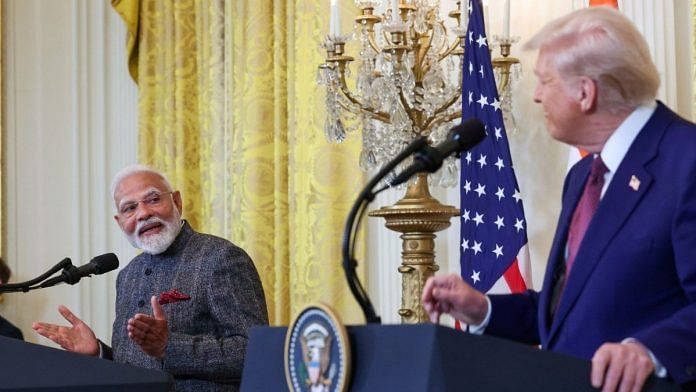In the ever-evolving landscape of global trade, few bilateral relationships are as strategically significant—and as periodically strained—as that between India and the United States. Though they ought to be natural partners in technology, defence, climate action, and global relations, the two democracies have often found themselves at cross-purposes over their trade policies. On 2 April, the Trump administration slapped India with 26 per cent additional trade tariffs, but announced a 90-day moratorium a week later.
India is expected to utilise this period to address longstanding trade imbalances and shape a more equitable framework for future cooperation. The negotiations will delve into complex issues ranging from agricultural exports and digital trade to pharmaceutical pricing and e-commerce regulation. India will be keen to push through the terms negotiated during Prime Minister Narendra Modi’s visit to the US this year.
In this context, the 90-day pause in tariffs is a strategic test. It will determine whether both nations can translate geopolitical goodwill into concrete, mutually beneficial trade outcomes.
India-US tariff tension
Over the past decade, India-US bilateral trade has expanded significantly. In 2023-24, the US was India’s largest trading partner, with bilateral trade crossing $119 billion. However, this growth has not been without friction. The US has consistently voiced concerns over India’s tariff regime, which it considers among the highest for a major economy.
“The Prime Minister [Modi] just left. He’s a great friend of mine, but I said, ‘You’re a friend of mine, but you’re not treating us right.’ They charge us 52 per cent. You have to understand, we charge them almost nothing, for years and years and decades,” President Trump said after Modi’s visit in February. India, in turn, expressed frustration over what it sees as America’s reluctance to accommodate the developmental needs of emerging economies.
Tensions escalated in 2019 when the US imposed tariffs of 25 per cent on Indian steel and 10 per cent on aluminium, citing national security concerns. India responded with retaliatory tariffs, which was followed by the Trump administration’s revocation of India’s benefits under the Generalized System of Preferences (GSP). This affected nearly $6 billion in Indian exports. The fact that India and the US don’t have a comprehensive bilateral trade agreement further complicates matters.
With Trump escalating trade tensions, especially with China, the 90-day moratorium presents a rare opportunity to strike while the iron is hot.
For India, the temporary suspension of additional tariffs—effective until 9 July—brings both short-term relief and strategic uncertainty. The pause protects Indian exports in key sectors like steel, auto parts, and electronics from immediate tariff shocks. However, it also sets the stage for high-stakes negotiations within a limited timeframe. Washington expects quick movement on long-standing trade issues.
The challenge for Indian negotiators is to safeguard domestic priorities while also securing stable and long-term access to the US market.
Also read: Why the US can devastate everyone and still emerge stronger
Current tariff negotiations
Negotiators from India and the US are re-engaging on a wide range of tariff and non-tariff barriers hindering bilateral trade. The talks address asymmetries in tariff structures, market access concerns, and diverging regulatory approaches.
India maintains relatively higher tariffs in agriculture (39.9 per cent against the US’ 5.3 per cent), automobiles (24 per cent vs 1 per cent), and industrial goods. These, according to US trade officials, create an uneven playing field for American exporters.
On the other hand, India has long sought greater access to the US market for its pharmaceutical products, textiles, and skilled services. This has been hindered by US concerns over intellectual property protection, regulatory compliance, and visa restrictions.
Similarly, the US views India’s data localisation requirements and proposed digital services taxes as discriminatory against American tech firms. But India must defend these measures to ensure data sovereignty—our data must remain in our own hands.
A strong US-India trade relationship will add credibility to the Indo-Pacific Economic Framework (IPEF) and the Quad, and reinforce India’s role as a key economic and security partner in the region.
On the other hand, any trust deficit created by tariff wars, retaliatory duties, and inconsistent policy will undermine investment opportunities and long-term collaboration.
Also read: China-US trade war has parallels with Japan in WW2. Will it escalate to military conflict?
Implication for policy decisions
With Trump-era protectionism once again shaping Washington’s trade posture, India faces the dual challenge of defending its economic interests while reinforcing its role as a reliable, rules-based partner.
The 90-day pause on tariffs should be used not to implement sweeping trade reforms but to secure targeted, confidence-building agreements. This involves reducing tariffs on specific industrial goods, enhancing regulatory cooperation in pharmaceuticals, and setting interim guidelines for digital trade. Such incremental progress can lay the groundwork for broader negotiations once political conditions stabilise in both countries.
American vice-president JD Vance is expected to visit India this month. He will likely build upon the Bilateral Trade Agreement (BTA), which was unveiled following a meeting between Modi and Trump on 13 February—the day the US announced its new reciprocal tariff framework. Both nations have set a target to expand bilateral trade from the current $200 billion to $500 billion by 2030.
India must also take a whole-of-government approach to trade diplomacy. It must engage US stakeholders beyond the executive branch. State governments, business lobbies, and civil society groups can help shape a more resilient trade partnership.
If handled deftly, the 90-day reprieve can serve as a strategic reset, helping both nations navigate economic nationalism at home while preserving the long-term vision of a high-trust, high-growth economic relationship.
Meenakshi Lekhi is a BJP leader, lawyer and social activist. Her X handle is @M_Lekhi. Views are personal.
(Edited by Prasanna Bachchhav)






